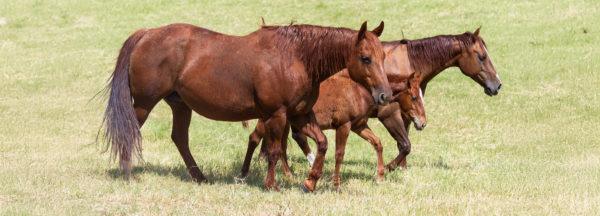Can’t Separate Filly from Her Mom


Can't Separate Filly From Her Mom - Q&A With Clinton Anderson
For the past 20 years, Clinton Anderson from Downunder Horsemanship has devoted his life to creating the best training tools and videos to help bring his method to you. Join him on his weekly endeavors to tackle some of the most challenging situations with problem horses and problem owners. This week, we watch as Clinton addresses a viewer’s concern about her filly and the separation anxiety she’s witnessing.
We begin this week listening to a horsewoman’s concerns regarding her new filly. She says that she keeps the filly in a barn, about five stalls away from her dam. 95% of the time, the two horses don’t care much about each other aside from the occasional calls back and forth. However, the filly has started being turned out in the roundpen in their indoor arena. The issue is that when our viewer is not near the roundpen, the filly will keep pawing at the ground and sticking her legs through the panels. When she is near the roundpen, everything seems fine. Our viewer is nervous that her filly will hurt herself trying to adjust to this separation anxiety she’s experiencing, as she’s in a boarding facility with limited control over the panel arrangement.
Clinton starts out by mentioning his distaste for portable panels and their use as stalls. There’s just too much risk with a horse injuring or permanently damaging their legs. Instead, he says you should use something with solid walls that’s at least five feet tall. This makes it so your horse can’t get their legs through panels and end up hurt. If you are going to use portable panels, use panels that are at least six feet tall. This way, your horse can’t get their neck over it easily or try to jump out.
Clinton then goes on to respond to his viewer, saying that what’s going on with her filly is a type of anxiety. The filly might be anxious because she’s been moved away from her mother, which is usually just a maturity thing. It should go away with time, but it can still be problematic and difficult to watch.
Clinton’s advice in this situation? Just walk away. The filly needs to learn to deal with it on their own. However, he does stress the fact that if you do this, it’s important to have a safe environment where you’re not worried about the horse getting their legs through the panel or trying to jump through the stall. Clinton mentions that his stalls are designed with yokes that can be removed so a horse can stick their head and neck out of the stall and see down the alley of the barn. However, when he first gets in a young horse or an untrained horse, he keeps the stall’s yoke in to avoid any issues. Usually, if a horse can put their head and neck somewhere, they think their body can follow. And this can quickly turn into a disaster.
Clinton also explains how when you wean a foal (whether it’s a filly or a colt) from a mare, it can be challenging if they stay in the same place. They become barn buddies and they kind of become hooked to each other. So, whenever Clinton has weaned a foal in the past, he will take the mare completely off the property (or to the opposite end) so they can’t see or hear each other. This cuts their bond and makes it easier for the foal to move on without as much anxiety and worry about where the mare is. A clean-cut is the best way to get it over with. In fact, Clinton says that with a clean cut, the foal may be stressed for about 24 hours, but then they move on. You’ll want to put them in a small pen where they can move around during the transition, but not in a big pasture where they can gallop and potentially go through a fence.
Regarding the situation with this viewer, Clinton realizes that she might not be able to just walk away because of the risk of her filly getting her legs stuck in the panels. The easiest solution that Clinton offers is to try and find another place where she can keep the filly—somewhere that offers a safe environment and no risks to the filly getting her legs caught in a panel.
To learn more about the Downunder Horsemanship training method, become a member of the No Worries Club, or get information on any of the products featured on our show, visit our homepage and download the Downunder Horsemanship app today!

